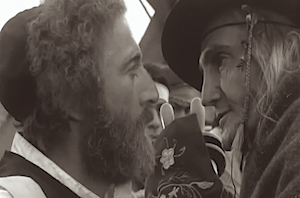
Founded on Passover 1799 by a youthful colony of Spanish Jews fleeing the persecution of their parents, at its height the mission comprised a thriving community of several hundred souls along the Los Angeles River, near present-day Boyle Heights.
Often overshadowed by its overachieving Catholic neighbors in San Gabriel and San Fernando, Mission Santa Zipporah was founded by the storied ‘Father’ Shmuel, the Jewish missionary sometimes known by his nickname, “Father Sarah.”
Little is definitively known about the charismatic padre. Born in Castille in 1776 to a fishmonger and his bride, Shmuel was a musical child. He entered yeshiva at 17 with the intention of emulating the heroes of his youth and becoming a cantor. The few extant records suggest that Shmuel left seminary soon afterward, possibly after his pronounced Castilian lisp produced giggles during services.
Shmuel longed to share his faith with the wider world. Undeterred by Judaism’s traditional disinclination to proselytize, he boarded a ship for New Spain. Legend has it he brought with him only his miniature Torah scroll and a cassock knitted for him by his mother.
His long and queasy ocean voyage figures among the few sayings of Father Shmuel that survive. “Milk and meat should go down separately,” he once said of Jewish dietary laws. “Up is in God’s hands.”
Shmuel’s fine manners, and the delicious care packages his mother had waiting for him exotic ports of call, soon won the worshipful attention of his shipmates. He had thought to sail with them as far as Alaska, but by the time they put in at San Pedro in the spring of 1799, he was ready for a change of scene.
When the Chumash Indians paddled out in a flotilla of dugouts to meet his ship, Father Shmuel felt on his shoulder the hand of destiny. The natives in their sturdy canoes rowed him upstream as far as the still-sleepy pueblo of Los Angeles, finding fine arable land in the flats just east of the river, and hillsides conducive to viticulture above.
On Passover, April 1, 1799, the good padre dedicated Mission Santa Zipporah with the exclamation “E clampus vitus”: an obscure expression he had picked up in his travels, sometimes translated as “I didn’t want to impose.”
Father Shmuel then set about recruiting nearby Native Americans to his mission. This he did in keeping with the traditions of his people by starting to work himself, and waiting for the tribesmen to feel guilty and join in.
This occasioned considerable merriment among the locals, many of whom had run away from other missions and were grateful for the respite. Later, when the padre’s incessant mutterings of “Don’t mind me, I’ll just till this soil myself” grew tiresome, some hardy braves were even seen to grow nostalgic for the lash.
Others, however, soon set to work alongside Father Shmuel. Their first crop produced a dozen barrels of sacramental wine, plentiful loaves of unleavened bread, and some quantities of a bland broth made from poultry, reputed to possess medicinal properties. The work was hard, the days long, and the padre feared for the survival of his little mission.
It was then that the miracle happened. One day Father Shmuel was cooking his favorite hardtack over the mission’s crude hearth, enjoying the fellowship of two of his charges: a comely woman he had named Beatriz, and Chumash Chief Alfonso.
Accounts differ as to how the concoction first appeared. It seems likely that Beatriz, weary of the benevolent padre’s reliance on this unpalatable staple, substituted a stub of jerky, while Alfonso, accustomed to even more savory fare, provided the spices.
Of the result, there can be no doubt. After what came to be called the “Miracle of the Knishes,” Father Shmuel saw at once that the mission’s success was assured. (Knishes are a Jewish stuffed bread similar to empanadas or papusas.)
Soon, drovers rode in from leagues around to sample the mission’s signature delicacy. Shmuel converted the stables into a great hostelry — his only lasting conversion, it might be added — with upholstered stalls, and a great kitchen of adobe to accommodate demand. Over it all he painted a sign memorializing his long-ago heroes, the cantadores.
But success was not to last. In 1834 the Mexican government secularized the missions, and Father Shmuel’s business dropped off almost overnight. Here the historical record grows ever more obscure. Some say Shmuel, lonely after his years of labor, rode off some leagues to Rancho San Vicente y Santa Monica in the west in search of a nice Jewish girl, and reopened his beloved establishment there. Others claim he lies buried beneath the gazebo in modern-day Mariachi Plaza, his mislaid bones and relics jolted by every Gold Line train that shuttles through.
All that remains of this once-thriving settlement is a blurry marker set in the wall of Santa Cecilia’s Mexican restaurant by the Civilian Conservation Corps in 1939, designating the entire blufftop as “Mission Santa Zipporah de la Culpa State Park.”
Even that grows harder to make out in the magical twilight that nightly gilds the redeveloped plaza, where First, Boyle and Pleasant Streets used to intersect, almost in a kind of star. The state will spend several thousand dollars this spring removing the plaque because of budget cuts.
Father Shmuel’s first meeting with Chumash Indians was a little tense:
—————–
On Mariachi Plaza in Boyle Heights, David Kipen has just unveiled the new Libros Schmibros, a lending library/used bookshop he founded in 2010. He can be fact-checked at kipend@gmail.com.
